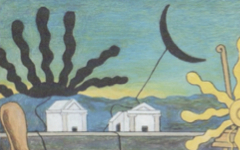De Chirico’s Sun on the Easel (1973) Part 1
Many of De Chirico’s images seem difficult to understand or make sense of. However, if you familiarize yourself with the ideas presented on this site, you will begin to recognize that under the surface originality of his art, the meaning in his images is quite conservative. He created a new look in tune with the times for basic themes that the great masters had riffed on for centuries, as he demonstrates here. He, like other artists, had no choice, of course. Just as new forms of the Inner Tradition appear on a regular basis to suit the period culture, so the underlying message in these spiritual practices, reflecting basic truths, remains the same,
In this canvas, Sun on the Easel, the theme of insight and out-sight is clearly apparent as he places a glowing sun (representing exterior sight) and a bright moon (interior thought) inside his studio with their darkened counterparts outside. By themselves the sun and moon had long represented both forms of perception but, here, he doubles them, placing both bright inside and both dark outside.
He suggests, as artists often do, that the window in the background is a framed painting. We are looking at how his imagination inside the studio transforms into a landscape painting outside. Landscape in art, De Chirico says here, is not a copy of the exterior world, as the ordinary viewer naturally thinks, but a reflection of the artist's mind. It is what Chinese artists sometimes call a Mindscape.

Left: Detail of De Chirico's Sun on the Easel
Right: Detail of De Chirico's Self-Portrait (1920)
Click image to enlarge.
We know that the scene takes place in his mind because the lines linking the moons echo the shape of his prominent nose, an iconic feature that he often used to symbolize himself. The string near the white moon curves upwards to suggest the opening of his "nostril" while the white moon itself echoes the "curved crease" to the side of his nose. The black moon represents his pupil, combining in one form out-sight and insight
Click next thumbnail to continue
Meanwhile the two darkened entrances to the two white temple-like structures seem to suggest "eyes" peering over the top of the window ledge, as indeed they are. Entrances and the verb "to entrance" are linked as they are here. They are the "eyes of Chardin" as you can see in a sequel to this article, De Chirico's Sun on the Easel, Part 2.
More Works by De Chirico
Notes:
Original Publication Date on EPPH: 21 Jun 2011. | Updated: 0. © Simon Abrahams. Articles on this site are the copyright of Simon Abrahams. To use copyrighted material in print or other media for purposes beyond 'fair use', you must obtain permission from the copyright owner. Websites may link to this page without permission (please do) but may not reproduce the material on their own site without crediting Simon Abrahams and EPPH.





